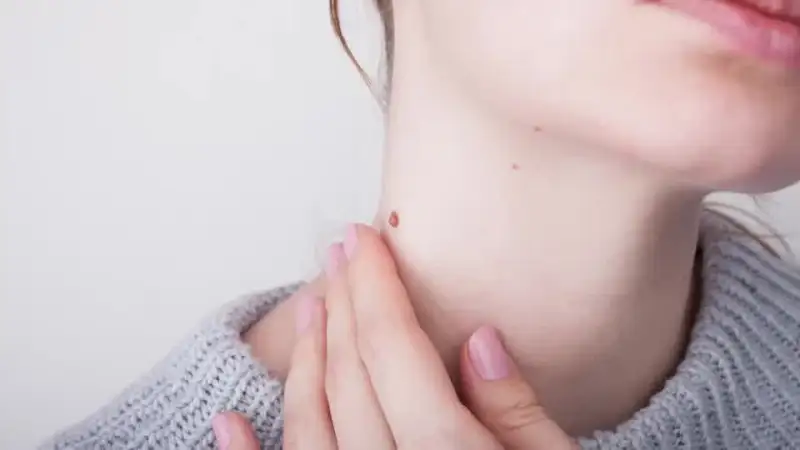Imagine waking up to a skin tag or wart that just vanished overnight, like some blemish fairy waving her magic wand. Sounds too good to be true? Believe it or not, this may be more achievable than you think.
You’ve probably spotted these pesky little growths before–stubborn tenants on your body’s prime real estate–and wondered why they picked you. I get it; they’re unwelcome, uninvited, and downright annoying.
But hold tight because we’re about to dive deep into the nitty-gritty of what makes these bumps tick and how you can send them packing by sunrise. So buckle up; this isn’t your average bedtime story–it’s one where you could wake up with smoother skin!
Understanding Skin Tags and Warts
Skin tags are like those uninvited guests who pop up out of nowhere at a party. They’re small, hang by a thin stalk on your skin, and are mostly harmless.
Then you’ve got warts, the rough-textured intruders that can march in clusters or stand-alone anywhere they please on your body.
But why do these pesky tag-alongs decide to appear? Our DNA plays host to the human papillomavirus (HPV), which gets cozy in our skin cells and often throws these little growth parties.
Surprisingly common among adults–with two out of three carrying HPV without even knowing–it’s no wonder many folks find themselves seeking ways to show these unwelcome visitors the door.
The Connection Between HPV and Skin Growths
You might not realize this, but having certain types of HPV is like holding an open house for skin growth. Studies have shown that four out of seven people will experience some wart during their lifetime because of this virus.
This research dives into how specific strains invite both benign pals–like noncancerous warts–and more ominous ones that could potentially lead to cancer if left unchecked.
Identifying Common Areas for Warts and Skin Tags
Sure, as rain falls from clouds, there are spots where warts love setting up camp more than others–think fingers, elbows, knees… And let’s not forget about necklines; nearly eight times likelier places for those dangling bits known as skin tags.
Factors Influencing Skin Tag and Wart Development
Skin tags and warts are like the uninvited guests of the skin world, popping up when you least expect them. But what turns on the welcome sign for these pesky intruders? It’s a combination of factors that could make your skin their next hot spot.

The Role of Hormones in Skin Growth Formation
Hormones, especially estrogen, can be party crashers in this scenario. When it throws its weight around too much, you might see an uptick in unwanted skin accessories.
Think about puberty or pregnancy; these hormone-heavy times often lead to more frequent sightings of both skin tags and warts.
Beyond life stages, conditions like polycystic ovary syndrome (PCOS) also show us how hormones can roll out the red carpet for these growths–just another joyous side effect to add to PCOS’s list.
Insulin Resistance, Diabetes, and Skin Abnormalities
Moving on from hormonal hijinks to blood sugar battles, insulin resistance ups the ante when developing those stubborn skin stowaways. High blood sugar is no friend either–they’re pretty friendly with wart development, too.
If diabetes enters into this mix, research shows, it invites even more chaos by compromising your body’s ability to send these unwelcome visitors packing.
We’re not just talking small talk here–these findings are big news if you’re looking at why some folks have a full-fledged reunion while others don’t get so much as a knock at the door from these bothersome bumps.
The Immune System’s Battle Against HPV
Imagine your immune system as an elite security team. Usually, it does a stellar job at keeping the bad guys–like viruses–at bay. But when HPV sneaks in, it’s like a master of disguise that can go unnoticed by our bodyguards.
Natural Killer Cells’ Function in Virus Defense
Natural killer cells are part of this crack team, working tirelessly to identify and remove virus-infected cells before they cause real trouble.
These cellular heroes come equipped with an arsenal designed to detect and destroy abnormal cells harboring viral invaders such as HPV, which could potentially lead to cancer if left unchecked.
These vigilant defenders aren’t perfect, though; sometimes warts or skin tags pop up on our skin–a telltale sign that HPV has managed a sneak attack despite their efforts.
Factors Weakening Our Immune Response
You might not realize it, but simple things like stress or lack of sleep can destroy your immune response game. It’s like expecting those security guards to work double shifts without breaks–they will eventually miss something.
This isn’t just hearsay; studies have shown that lifestyle factors impact how well natural killer cells work against viruses.
And let’s be honest: most people don’t think about nurturing their immune systems until there’s already trouble brewing beneath the surface–that is when odd growths make an unwelcome appearance on their bodies.

Practical Overnight Remedies for Skin Tags and Warts
Picture this: you’re brushing your teeth before bed when you spot a pesky skin tag or wart in the mirror. You want it gone, fast. Before discussing overnight fixes, remember that patience is vital, and some methods might take longer.
Now, onto those nighttime tactics. Apple cider vinegar has been touted as an all-natural remedy for everything, including these stubborn growths. Soak a cotton ball with it, place it over the area, secure it with a bandage, and let the acidic magic work while you sleep.
If vinegar isn’t your style–maybe because of its intense aroma–you can turn to tea tree oil instead. It’s known for its antiviral properties, which could be helpful since HPV strains cause many warts.
Dabbing on tea tree oil nightly may help them bid adieu by morning–or at least start their goodbye process.
Last but not least: garlic–a kitchen staple that doubles as an anecdotal overnight wonder cure due to its antiviral prowess (make sure to protect surrounding skin with petroleum jelly).
Crushed garlic taped over the blemish aims to show it who’s boss by dawn’s early light, though fair warning, vampires might steer clear too.
All jokes aside–and please consult your doctor before trying any home treatment–these remedies have been sworn by folks wanting quick results without clinical intervention.
Strengthening Your Immune System to Combat HPV
Battling HPV goes beyond just addressing symptoms–empowering your immune system as the frontline defense. A well-nourished body is like a fortress; it can easily withstand and repel viral invaders.
Nutritional Support for Immune Health
Eating foods rich in particular nutrients can be your armor against infections. Vitamins like A, C, D, and E and minerals such as zinc are crucial for maintaining an optimal immune response.
Think of these vitamins and minerals as the bricks that fortify your castle walls–without them, you’re vulnerable to attack. Foods packed with antioxidants also play a crucial role.
They mop up free radicals–the saboteurs that threaten cellular integrity–and help keep our internal systems running smoothly. Imagine antioxidants as the castle guards who vigilantly patrol day and night to ensure no harm comes to the kingdom within.
Active Hexose Correlated Compound (AHCC) as an Immune Enhancer
AHCC might sound like something from a sci-fi flick, but think of it as reinforcements called into battle when extra support is needed.
This mushroom extract has been shown by research studies at reputable institutions such as The University of Texas Health Science Center to enhance natural killer cell activity, making it another powerful ally in fighting off persistent viruses, including HPV.
Incorporating AHCC into your diet could potentially give those natural killer cells–an integral part of your immune army–a much-needed boost so they can detect and destroy virus-infected cells before they cause trouble.
It’s akin to upgrading your troops’ gear to equip them better on the battlefield.
Conclusion
Imagine this: you know the secret handshake to dealing with those stubborn skin bumps. Understanding their HPV link and common hideouts is your first win.
Nailing down the hormone dance and how it ties into insulin resistance? That’s turning pro in spotting why these guests crash at your skin party.
Digging into your immune system’s fight club against viruses lays out how much backup you’ve got internally–and what could weaken it.
How to remove skin tags and warts overnight isn’t just a dream; it’s knowing which home remedies might do the trick while you’re off in dreamland. And keeping that immune system buff is like having an ace up your sleeve for the next time HPVs try crashing the party.
Your takeaway? Knowledge is the power to reclaim smooth terrain on your body’s landscape by morning light!








